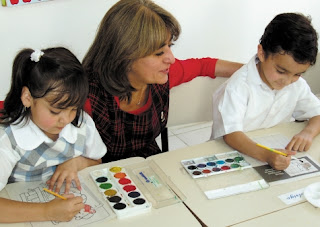
Early in my first year in the Montessori classroom, I learned that “shush” and “shhhh” are harsh sounds. While some may think that “shush” is a quiet way to calm a child’s behavior, the action has some undesired consequences. When a child is “shushed,” not only do you call the child’s attention to the matter, but as in the above example, everyone within hearing distance also notices. This seemingly innocuous sound breaks concentration and focus for everyone around. More importantly, rather than being discreet it has the potential to be quite embarrassing for the child.
Quiet in the Montessori Environment Promotes Skill Development... But How Do You Promote Quiet?

- Use sign language — Using the signs for “quiet” or “calm” is discreet and respectful. It works well for individual children and it is also effective in large group settings.
- Place a gentle hand on the child’s shoulder — No words are needed. The calm, reassuring touch quickly redirects focus and attention.
- Use specific language — Approach the child individually and use specific language to indicate your concern. For example, you may try something like, “Noah cannot hear my lesson when you are humming.”
- Turn down competing sounds — Take notice of the classroom environment. Perhaps the new world music CD is too upbeat to play during the morning work cycle. Turn it off or switch to a softer collection.
- Go outside — If you notice that you are having a morning where you are constantly redirecting behavior or calming noise level, go outside and let the children use their “outside voices.” Nature is a wonderful way to balance behavior.

The most powerful tool a Montessori teacher has to quiet and calm behavior is to consistently model appropriate behavior and volume herself. If you are loud, expect the children to be loud. If you speak in soft, calm tones, the children will too. Rather than calling across the room, approach a child directly, even if it means you need to get up and walk over to him. We must be constantly aware that we are the role models for our students. If we do not want to be “shushed,” then we should not “shush” others.
As much as possible, NAMC’s web blog reflects the Montessori curriculum as provided in its teacher training programs. We realize and respect that Montessori schools are unique and may vary their schedules and offerings in accordance with the needs of their individual communities. We hope that our readers will find our articles useful and inspiring as a contribution to the global Montessori community.
© North American Montessori Center - originally posted in its entirety at Montessori Teacher Training on Tuesday, August 27, 2013.
© North American Montessori Center - originally posted in its entirety at Montessori Teacher Training on Tuesday, August 27, 2013.

Thank you for this, often the children shush each other, especially when they are new to the environment. Then us adults also turn our heads to see where this sudden harsh noise came from...
ReplyDeleteOne thing that really helps is making sure that the child is READY to enter the Atrium or Montessori classroom. Last week I had a child that I could tell was going to be fast and loud, before he entered the Atrium, I stopped him and WITH him closed eyes and took deep breaths until I could see a calmness in his spirit. In Godly Play one adult is stationed at the door to help the child be ready before he or she enters. I wonder how that works.
ReplyDeleteGreat ideas thank you. We have the 'shush' problem too and I am going to try these ideas.
ReplyDeleteKim:)